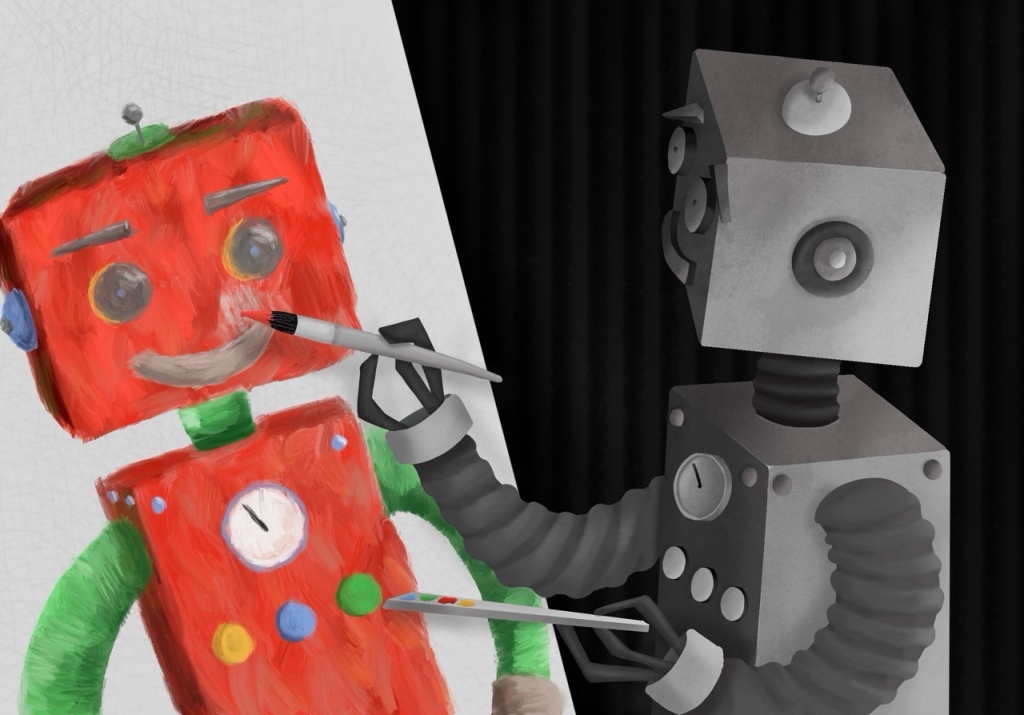No matter the industry, artificial intelligence promises to disrupt it. It’s become impossible to avoid the topic of AI, and how it’s coming for our jobs.
But what about the jobs of creative professionals? Can artificial intelligence be naturally creative? Are we replaceable? Or is the humanity of our creativity so valuable, that it’s impossible to replace with a machine?
What’s the value of creativity, and are humans an essential part of that value?
What I mean by “creativity”
To me, creativity is about filtering what’s happening around you—inputs—through who you are (your point of view, your experience, your identity, and your skills). Then, forming that into an output that you share back with the world.
Margaret Boden provides another useful definition, outlining three three types of creativity:
- Making unfamiliar combinations of familiar ideas.
- Exploring the boundaries of conceptual spaces.
- Recognising the limits of these conceptual spaces, and pushing beyond them.
So when humans are being creative, we are making combinations of ideas. But—crucially—we are also pushing the boundaries of these ideas, moving beyond them into something new.
The value of AI to make connections
AI can do this idea synthesis, but it plays within a set of ideas and boundaries that have been defined by humans. It is not capable of pushing those boundaries.
“I confess I have gone from being cranky to curious about AI, and I wonder what sorts of grunt work it could do for me.”
Austin Kleon
I’m not anti-AI. In fact, I’ve embraced it as a valuable tool in the creative process. It can take on some of the heavy lifting that we do in the course of our work, like reformatting, editing, summarising, and changing tone of voice.
Like Austin Kleon, I’m curious about AI. I think there’s a time and place for it in creative work. But it’s really limited to that first mode of creativity—making connections, distilling, adapting, converting. It’s great at working with what it’s given.
If creativity was only about making new combinations of ideas, then AI could be creative all day. But when you consider that creativity is also about pushing beyond the boundaries of what we already know, the value of humans in the creative process becomes more clear.
AI is a tool, not the artist
It’s important to make the distinction between a work of commercial creativity, or of personal expression. The former is far more likely to employ AI as a tool, while for the latter, AI has little use.
Bloomberg’s Roy Bahat breaks AI tools down into three categories:
- “Looms” — these generally can replace a person, as a fully-automated loom can replace a weaver.
- “Slide rules” — these assist a person, as a slide rule makes a calculation faster.
- “Cranes” — these allow a person to do something they otherwise would be completely unable to do themselves.
Generative AI tools are mostly slide rules for creatives. They assist creatives to summarise ideas faster, or to change the tone of something already written. Sometimes, they may be cranes, allowing us to do something we couldn’t do ourselves, but that would be the exception.
However, they’re not looms. There’s no fully-automated creative process machine that can filter a bunch of inputs through personal taste, experience, and identity.
They are a tool—sometimes a transformative one—but they cannot replace the essential humanity of the creative.
The value of humanity in creativity
To determine the value of AI in the creative process, we also need to explore the value of humanity in the creative process. What is the essential and irreplaceable value of humanity in creative endeavours?
“A work of art is an expression of human experience, and/or a communication between human beings, so machines simply don’t count.”
Margaret Boden
I’ve identified five human values of creativity, that (at least, at this stage in its development) AI is unable to replace. Unlike machines, humans are messy, they have taste, they struggle, and they are capable of self-reflection and joy. These aspects of humanity are what make creativity more compelling, and more effective as a means of communication.
The value of messiness
Humans are messy. When humans are involved, there is randomness and imperfection that makes a work of creativity compelling, interesting.
Robots can be programmed to play a perfect game of tennis. But who would watch?
AI is homogenous, vanilla. It only knows what it’s been programmed with, what it’s been fed. Its lack of human messiness, of soul, means it cannot make a connection with its audience.
As Margaret Boden puts it: “a computer could merrily produce novel combinations till Kingdom Come. But would they be of any interest?”
The value of taste
As humans, we all have preferences that define us. What we choose to like and not like, whether art, music, fashion, or hobbies, gives us the ability to filter inputs according to that taste. In turn, our taste determines the style of our creative output.
Machines, however, don’t have taste. They can’t discern between likes and dislikes, because they don’t like or dislike anything (unless they’ve been programmed to, but then that would be the taste of the programmer).
Our taste helps us connect to our audience, because it gives us a common ground on which to understand each other.
“As far as I know, algorithms don’t feel.”
Nick Cave
The value of struggle
Humans experience struggles, and overcome or succumb to these struggles. We may make a creative piece about the struggle, or the act of being creative in itself may be a struggle.
AI can’t struggle, and so its output lacks the markings of that struggle. It output is too clean, too sanitised, too easy, that it becomes untrustworthy.
As Nick Cave says, the struggle in creation is what gives the art meaning. When a song is borne out of struggle, “…the listener recognizes in the inner workings of the song their own blood, their own struggle, their own suffering.”
The value of self-reflection
Humans are capable of self-reflection. We are able to reflect on the piece we created, determine whether it was successful, and make improvements.
Without human intervention, AI can’t reflect on what it creates, determine whether it was successful, or iterate. Every output from a machine is just as good (or bad) as the last, and it is up to humans to decide what is worthy of keeping. We may decide to change our prompt or change the source material to get a better outcome, but that decision cannot be left up to the AI.
The value of joy
The act of creativity is often joyful (even commercial creativity). We often lose ourselves in the experience of creation, entering a flow state and feeling at peace and connected with ourselves. We feel accomplished when we’ve created something, and happy when others receive it well. Joy is so essential to the creative process that for many of us, if we no longer felt joy then we would simply stop creating.
AI, of course, can’t feel joy. It churns out words or images or videos with no emotion at all. And while we still arrive at the same outcome—we have the words, images, or video in hand—there hasn’t been any joy in its production. And therefore, some potential has been lost.
(However, if there parts of the creative process you don’t find joyful, consider using AI to replace them!)
I was enamoured with the idea of producing an image to accompany this blog post in a generative AI tool. I loved the humour and irony of producing an image of a beautifully-rendered robot painting its own self-portrait. But despite my best prompt engineering efforts, I simply could not get the machine to produce something as poignant and perfect as the idea in my head.
So in the end, I illustrated it myself—a process much longer, messier, more arduous, yet more joyful, than the AI version would have been. And therein lies its value.
Conclusion
While generative AI’s current form has much to offer creatives as a tool to help synthesise inputs, it does so within specific, human-programmed boundaries. Its inability to break out beyond these boundaries is what makes it incapable of producing meaningful creative output.
Put simply, AI tools lack several essential values of humanity necessary to connect creative work with its audience.
“This is what we humble humans can offer, that AI can only mimic, the transcendent journey of the artist that forever grapples with his or her own shortcomings. This is where human genius resides, deeply embedded within, yet reaching beyond, those limitations.”
Nick Cave

